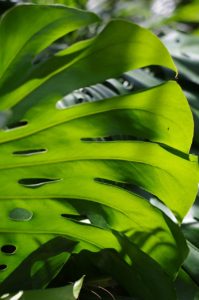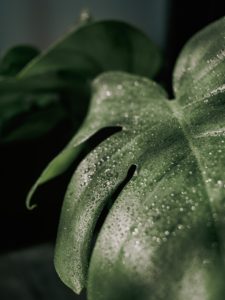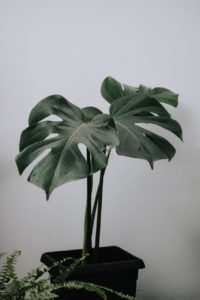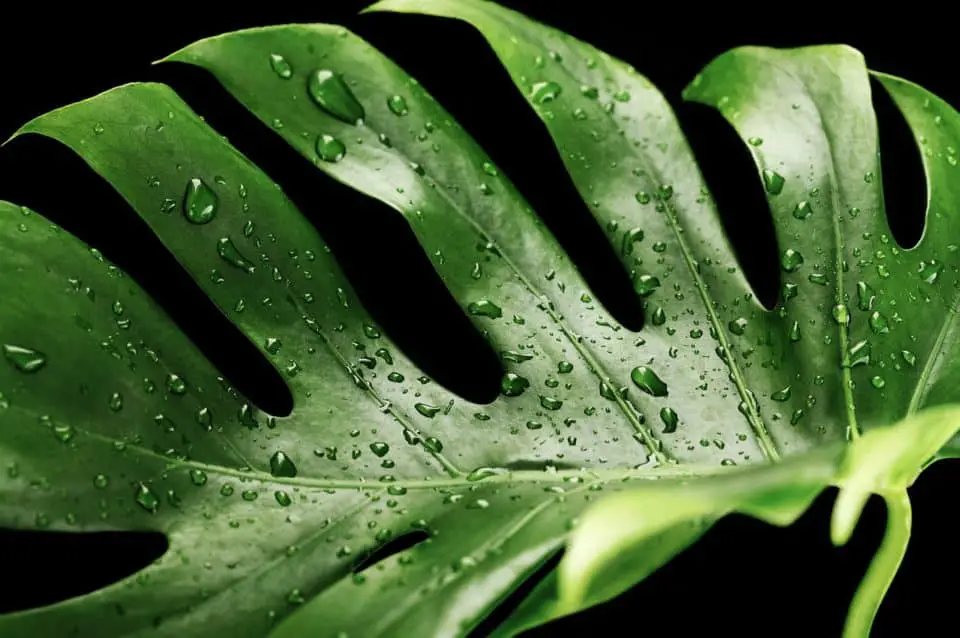Some links in the post are affiliate links and I get a commission from purchases made through some links found in the post.
You may know the monstera adansonii as the cheese plant. You may even have heard it called the ‘five holes plant’ because of the shape of the leaves.
In fact, it is the beautiful heart shaped leaves that make this plant so popular with gardeners everywhere.
The monstera adansonii grows to between 3-5 feet (or more) when kept as a houseplant and can grow to 13’ when outside.
While we gardeners take great pride in keeping our plants in the best health possible, occasionally they do things which confuse us and leave us wondering just what is wrong with them.
Your monstera adansonii is no different. In a healthy state it is a beautiful plant. However, one thing that does not look good on this plant is when it starts to droop or hang down.
Why is my Monstera Adansonii Hanging?
There are several reasons why your monstera adansonii may be hanging down so let’s look at them.
Underwatering
 Underwatering is the most probable cause for your monstera adansonii to be hanging. Not watering them adequately will cause the soil to become dry. Plants with not enough water will not survive.
Underwatering is the most probable cause for your monstera adansonii to be hanging. Not watering them adequately will cause the soil to become dry. Plants with not enough water will not survive.
You may not even be aware of this reason because your plant may continue to lose water through evaporation on the leaves and eventually no additional water will revive it.
Eventually you will be able to simply snap of the leaves as they will be completely brittle.
This is why it is so important that as soon as you see your monstera adansonii hanging, you should investigate the reason.
Too Much Water
A plant that is overwatered will start to become stressed and can easily hang down. You will also see that the leaves start to turn yellow.
Yellowing of the leaves is a sign that you are overwatering, and the roots are suffering. They may then go on to rot and eventually die.
If there is excess water in the soil, such as when there is inadequate drainage, the plant cannot get any nutrients. There will also be a lack of oxygen for the roots. This causes a condition known as root hypoxia.
You need to be aware that it is easier to help a plant that has been underwatered than one which has constantly been saturated, so make sure to check your watering routine as soon as you can.
Check the Temperatures
If the temperatures around your monstera adansonii keep fluctuating, your plant will become stressed. The plant may start to wilt and hang in excessive heat.
More water than normal will be lost, and the plant will almost become dehydrated.
Your monstera adansonii needs a temperature range of between 18°C to 27°C (64°F to 81°F) to do well. Too high above or too low will be detrimental to your plant.
Make sure that there are no cold draughts blowing around your plant as this can also cause hanging and wilting.
If you need help watering your plant, try using this automatic drip irrigation kit.
Humidity
Anything above 60% humidity will be ideal for your monstera adansonii. In fact, it can survive up to 90% humidity and still be perfectly happy.
A point to remember is that anything below 60% humidity will not be good for your plant. These plants came originally from rainforests and jungles where the humidity is high all the time.
A constant low humidity level will mean your plant loses more water than it should, and the leaves will start to hang.
Bugs and Pests
There are several insects and pests which can cause your monstera adansonii to hang, namely spider mites, aphids, mealybugs, and thrips.
These pests form an infestation and will suck the sap out of the plant. Once this happens your monstera will start to hang.
Keep an eye for tell-tale signs of pests. You may see tiny cobwebs or minute dots along the spines of the leaves. Treat as soon as you can to destroy the infestation.
Disease
The monstera adansonii is susceptible to Alternaria leaf spot and Septoria leaf spot, both of which will affect the normal function of the roots and the flow of nutrients to the plant system.
Watch the fertilizer
If you over fertilize your monstera adansonii your plant can suffer chemical toxicity and damage to the roots. Once the roots are affected the entire plant is at risk and the leaves will start to hang and wilt.
How to Care for a Monstera Adansonii
Considering how delicate the leaves of the monstera adansonii look, the plant is in truth quite easy to care for.
The pot you use must have good drainage and the potting mix you use should contain peat because this will help to retain moisture without getting waterlogged.
Pop your monstera adansonii close to a window where it will benefit from bright but (more importantly) indirect sunlight, but not in a draught.
Monstera adansonii does not like to be soaked and soggy but they enjoy a good watering and moist soil.
Keep an eye on the humidity, particularly in the winter when the air can be dry. You may want to invest in a small humidifier.
Based on the temperature and humidity in your home, you may need to water your plant once a week.
Note: A sign that you are not watering correctly is if the ends of the leaves start to turn yellow. You can test the dryness of the soil by inserting your finger into the mix near the stem.
The top one inch should be dry. If it is not, you are giving too much water.
For more on how to care for a monstera, check out our full beginners guide on how to care for a monstera.
Why is my Monstera Adansonii not Growing Leaves?
 There are several reasons why a monstera adansonii will stop producing leaves. By far the most common reason is because the plant is receiving too little light.
There are several reasons why a monstera adansonii will stop producing leaves. By far the most common reason is because the plant is receiving too little light.
Other reasons for the lack of growth are:
- Too much water or not enough
- Too small a pot
- Lack of nutrients
- Pests
Additionally, if you see that your monstera adansonii has stopped growing leaves with slits or holes this can be due to lack of fertilizer, inadequate light, and not enough water.
Can you put a Monstera in a Hanging Basket?
Yes, you can have your monstera adansonii as a hanging plant but a point to remember here is that the vines will keep growing longer and if left unchecked could soon fill an entire room!
A better way to deal with this is to construct a trellis so that your monstera can grow along it.
Because the monstera adansonii is a natural climber it responds well to trellis work and can be tied and trained to grow in any direction you like.
Is Monstera Adansonii Rare?
No, the monstera adansonii is not a rare plant. In fact, they are very easy to propagate and many gardeners, including amateurs grow multiple monsteras this way.
Is Monstera Adansonii Toxic to Dogs?
According to the list provided by the ASPCA, monstera plants of all kinds are toxic to pets.
Cats are attracted to the plant because it provides a good place to hide and sometimes trellis to climb. This should be discouraged by placing your plant where the cat and dog cannot get to it.
If one of your pets has eaten a leaf you may see irritation in the mouth area along with swelling. You will see excessive drooling, vomiting and often difficulty in swallowing.
You may also like: Is a Monstera Toxic to You and Your Pets?
Does Monstera Adansonii Grow Fast?
The monstera adansonii is classed as a quick growing plant. The best time for growth is from the spring to early fall when you may find that you spend a significant amount of time cutting the plant back.
If you have trained your plant to grow along a trellis you will see that it simply keeps going until it has nowhere else to go.
A newly propagated piece of plant will take about 3-4 weeks to establish itself.
How do you Make Monstera Adansonii Grow Faster?
You can speed up the growth of the plant by placing it close to a window or in an area where the plant receives the maximum amount of indirect sunlight.
Indirect light will encourage new growth without damaging the leaves.
How Much Light Does a Monstera Adansonii Need?
For your monstera adansonii to do well, it needs bright, indirect sunlight. You must ensure that it has at least six hours of this per day otherwise you will notice that the plant becomes leggy and looks sickly.
Make sure that this is indirect sunlight as direct light can burn the leaves, which is equally harmful for your plant.
If your plant is struggling due to light, trying using this to help regulate the lighting.
Now, it is worth knowing that your plant can survive in lower lighting areas, but you can expect to see slower growth. The converse is that if your plant is in direct sunlight for extended periods, the leaves will burn, and the plant may die.
It is worth bearing in mind that the plant originated from the jungles where they grow underneath other foliage and only receive indirect sunlight most of the time.
For more information check out our article on does a monstera like direct sunlight.
There are some signs to watch out for to tell you that your monstera adansonii needs more light, namely:
- The leaves do not split
- The soil takes a long time to dry out
- The tips of the leaves start to turn yellow
- The plant seems to grow really slowly
Note: In perfect conditions your monstera adansonii can easily grow up to 10 feet even inside your house so be ready to cut it back if you need to.
Bearing this in mind, if you do not see any new growth during the spring and summer months, it may be that the plant is simply not getting enough light.
Final Thoughts
 If you have the space for this beautiful plant to wind itself around your living room then you are a lucky person.
If you have the space for this beautiful plant to wind itself around your living room then you are a lucky person.
Monstera adansoniis are beautiful plants which with the right conditions and attention, will reward you with many years of growth.
They are not very difficult to take care of and will reward you tenfold for taking care of them.


